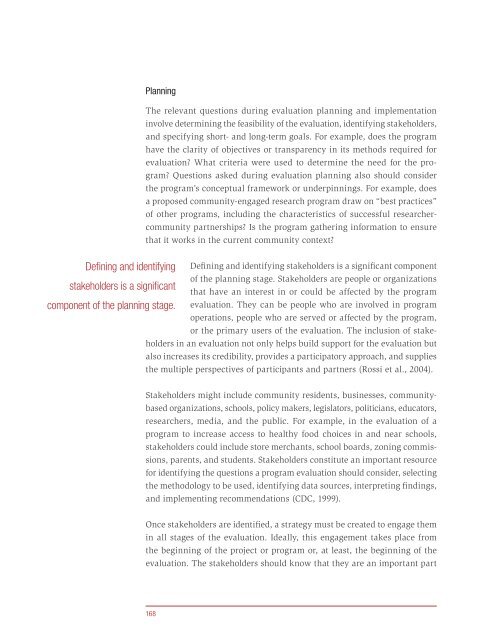Principles of Community Engagement (Second Edition)
Principles of Community Engagement (Second Edition)
Principles of Community Engagement (Second Edition)
You also want an ePaper? Increase the reach of your titles
YUMPU automatically turns print PDFs into web optimized ePapers that Google loves.
Planning<br />
Defining and identifying<br />
stakeholders is a significant<br />
component <strong>of</strong> the planning stage.<br />
The relevant questions during evaluation planning and implementation<br />
involve determining the feasibility <strong>of</strong> the evaluation, identifying stakeholders,<br />
and specifying short- and long-term goals For example, does the program<br />
have the clarity <strong>of</strong> objectives or transparency in its methods required for<br />
evaluation? What criteria were used to determine the need for the program?<br />
Questions asked during evaluation planning also should consider<br />
the program’s conceptual framework or underpinnings For example, does<br />
a proposed community-engaged research program draw on “best practices”<br />
<strong>of</strong> other programs, including the characteristics <strong>of</strong> successful researchercommunity<br />
partnerships? Is the program gathering information to ensure<br />
that it works in the current community context?<br />
Defining and identifying stakeholders is a significant component<br />
<strong>of</strong> the planning stage Stakeholders are people or organizations<br />
that have an interest in or could be affected by the program<br />
evaluation They can be people who are involved in program<br />
operations, people who are served or affected by the program,<br />
or the primary users <strong>of</strong> the evaluation The inclusion <strong>of</strong> stakeholders<br />
in an evaluation not only helps build support for the evaluation but<br />
also increases its credibility, provides a participatory approach, and supplies<br />
the multiple perspectives <strong>of</strong> participants and partners (Rossi et al , 2004)<br />
Stakeholders might include community residents, businesses, communitybased<br />
organizations, schools, policy makers, legislators, politicians, educators,<br />
researchers, media, and the public For example, in the evaluation <strong>of</strong> a<br />
program to increase access to healthy food choices in and near schools,<br />
stakeholders could include store merchants, school boards, zoning commissions,<br />
parents, and students Stakeholders constitute an important resource<br />
for identifying the questions a program evaluation should consider, selecting<br />
the methodology to be used, identifying data sources, interpreting findings,<br />
and implementing recommendations (CDC, 1999)<br />
Once stakeholders are identified, a strategy must be created to engage them<br />
in all stages <strong>of</strong> the evaluation Ideally, this engagement takes place from<br />
the beginning <strong>of</strong> the project or program or, at least, the beginning <strong>of</strong> the<br />
evaluation The stakeholders should know that they are an important part<br />
168

















